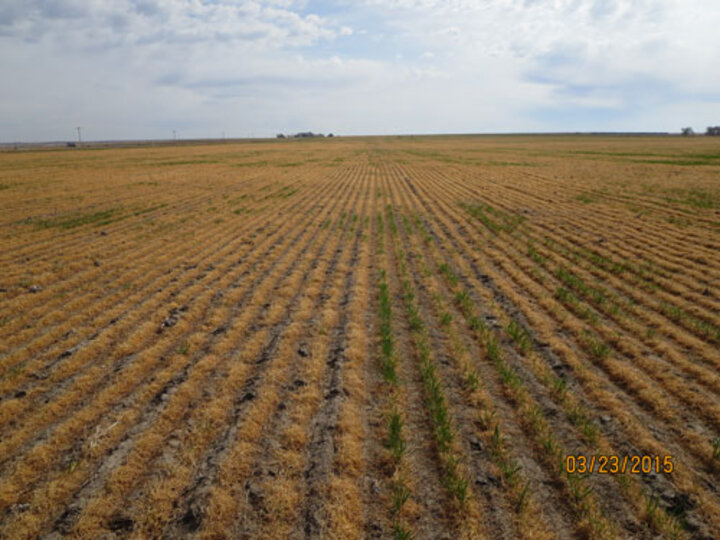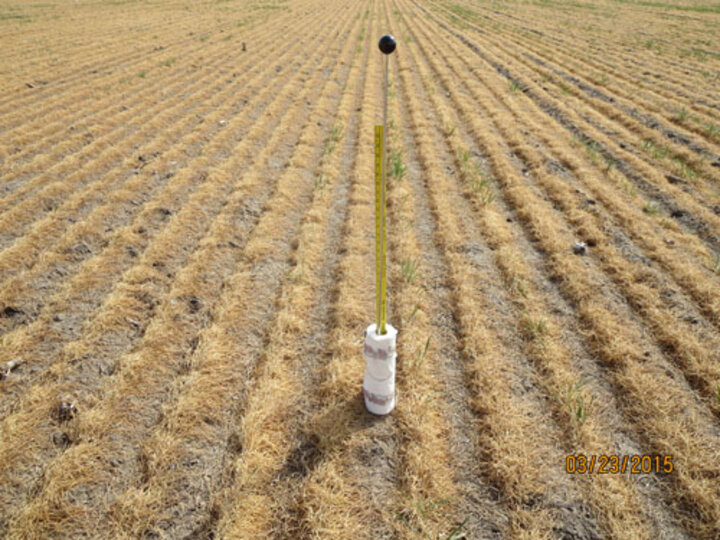

and how to enhance survival this year
Sept. 2, 2015
| Table 1. Data from Enders in southwest Nebraska reflect the harsh weather conditions and variability winter wheat experienced during the 2014-15 winter. | |
| Nov. 9 | 76°F |
| Nov. 13 | -7°F |
| Dec. 30 | -17°F |
| Dec. 31 | -15°F |
| Jan. 25-28 | No freezing temperatures; one high of 77°F |
| Feb. 1-2 | -1°F |
| Sept. 1-April 1 | 1.6 inches of rain |
During the 2014-15 Nebraska winter wheat faced an onslaught of extreme temperatures and dry conditions that led to winter injury and kill in southwest Nebraska as high as 60% to 80% in some fields (Table 1 ). Given the potential for damage, winter wheat producers will want to take appropriate measures to avoid repeat losses with the 2015-2016 crop.
A number of factors influenced the amount of winter injury and kill to winter wheat, including winter hardiness of a variety, seeding date and depth, and seedbed preparation.Winter Hardiness
Winter wheat varieties vary in their tolerance to winter injury. The 2015 Nebraska Fall Seed Guide lists winter hardiness on pages 12 to 15 along with other plant characteristics and insect and disease information.
Since we did not have the harsh winter conditions needed to evaluate many of the winter wheat varieties until this past winter, use these ratings along with other information to select varieties. Ratings in the 2015 Seed Guide were not updated to include the 2015 season injury.
In Kansas, wheat varieties were rated by the percentage of visual symptoms of winter injury, a combination of leaf injury and apparent loss of stand. Varieties that appeared to have less winter injury in spring 2015 included (alphabetical order): 1863, Byrd, Denali, Everest, KanMark, LCS-Pistol, SY Monument, T158, TAM 114, WB-Cedar, and Winterhawk (Source: K-State Agronomy Update, Issue 501, April 3, 2015).
In southwest Nebraska trials the winter wheat varieties with less than 10% winter injury this year were (in alphabetic order): Bearpaw, Byrd, Infinity, Mace, Mattern, McGill, Monument, Overland, Robidoux, Scout 66, Settler, T158, Turkey, and Wesley.
Seeding Date
| Table 2. Winter wheat seeding dates and yields at North Platte. | |
| Seeding Date | Yield (bu/ac) |
| Sept. 2 | 2 |
| Sept. 15 | 27 |
| Sept. 25 | 42 |
Seeding date was another factor affecting winter injury and kill. Early seeded winter wheat had the most injury this year.
Low temperatures kill winter wheat plants by injuring the crown. When adequately hardened, crowns can tolerate temperatures down to -9 to -11°F. The hardening process is the key to a plant's ability to withstand low temperatures. Plants that develop several tillers because of early seeding remain more vulnerable to low temperatures than those seeded later. Plants in the three-leaf or four-leaf stage with good root systems are in the best position to survive the winter in the Central Great Plains.
Wheat plants are subject to desiccation due to cold, dry winds and a lack of adequate snow cover. Soil- and seed-inhabiting fungi can parasitize weakened plants and limit their ability to recover in the spring. Winter wheat that remains green in November/ December because of a long growing season may be severely injured by a rapid temperature drop in late fall and early winter. Temperatures that fluctuate from below 0°F to above 70°F during winter undoubtedly affect winter hardiness. Each time a plant breaks dormancy during winter, it loses some of its winter hardiness.
UNL research at North Platte shows how seeding date can affect yields (Table 2).
Adjust seeding dates according to soil type and location (see recommended dates) and whether the area is subject to wind erosion, which may require earlier seeding. With limited precipitation in fall 2014, early planted wheat dried out the soil going into winter. Dry soil warms up and cools down six times faster than moist soil.
Sedbed Preparation and Seeding Depth
A loose seedbed also contributes to winter injury and kill. In many fields the tire tracks, which firmed the soil, had less winter injury.
Shallow seeding depth also contributed to winter injury. Seeds placed near the surface resulted in the crowns being close to the soil surface and exposed to the harsh winter conditions. Many drills need additional weight to place the seed at the proper depth, optimally 1 to 1.5 inches. Coarse textured soils can be seeded at 1.5 to 2 inches. Usually it is best to seed near the maximum depth recommended.
Varieties with short coleoptile limit planting depth.
Robert Klein
Extension Western Nebraska Crops Specialist
